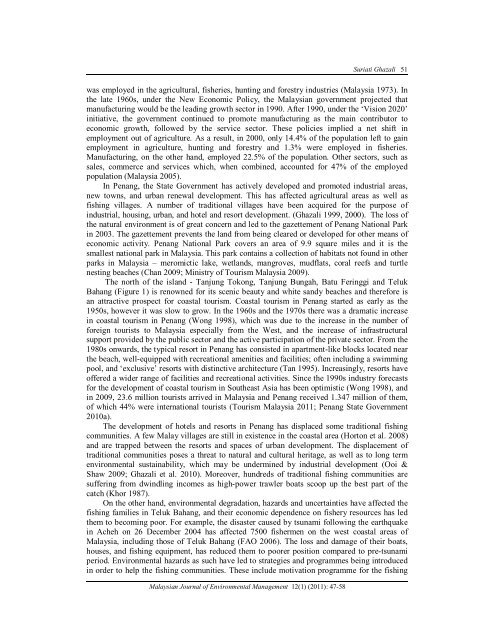Safeguarding Natural and Cultural Heritage - Malaysia Journal of ...
Safeguarding Natural and Cultural Heritage - Malaysia Journal of ...
Safeguarding Natural and Cultural Heritage - Malaysia Journal of ...
Create successful ePaper yourself
Turn your PDF publications into a flip-book with our unique Google optimized e-Paper software.
<strong>Malaysia</strong>n <strong>Journal</strong> <strong>of</strong> Environmental Management 12(1) (2011): 47-58<br />
Suriati Ghazali 51<br />
was employed in the agricultural, fisheries, hunting <strong>and</strong> forestry industries (<strong>Malaysia</strong> 1973). In<br />
the late 1960s, under the New Economic Policy, the <strong>Malaysia</strong>n government projected that<br />
manufacturing would be the leading growth sector in 1990. After 1990, under the ‘Vision 2020’<br />
initiative, the government continued to promote manufacturing as the main contributor to<br />
economic growth, followed by the service sector. These policies implied a net shift in<br />
employment out <strong>of</strong> agriculture. As a result, in 2000, only 14.4% <strong>of</strong> the population left to gain<br />
employment in agriculture, hunting <strong>and</strong> forestry <strong>and</strong> 1.3% were employed in fisheries.<br />
Manufacturing, on the other h<strong>and</strong>, employed 22.5% <strong>of</strong> the population. Other sectors, such as<br />
sales, commerce <strong>and</strong> services which, when combined, accounted for 47% <strong>of</strong> the employed<br />
population (<strong>Malaysia</strong> 2005).<br />
In Penang, the State Government has actively developed <strong>and</strong> promoted industrial areas,<br />
new towns, <strong>and</strong> urban renewal development. This has affected agricultural areas as well as<br />
fishing villages. A number <strong>of</strong> traditional villages have been acquired for the purpose <strong>of</strong><br />
industrial, housing, urban, <strong>and</strong> hotel <strong>and</strong> resort development. (Ghazali 1999, 2000). The loss <strong>of</strong><br />
the natural environment is <strong>of</strong> great concern <strong>and</strong> led to the gazettement <strong>of</strong> Penang National Park<br />
in 2003. The gazettement prevents the l<strong>and</strong> from being cleared or developed for other means <strong>of</strong><br />
economic activity. Penang National Park covers an area <strong>of</strong> 9.9 square miles <strong>and</strong> it is the<br />
smallest national park in <strong>Malaysia</strong>. This park contains a collection <strong>of</strong> habitats not found in other<br />
parks in <strong>Malaysia</strong> – meromictic lake, wetl<strong>and</strong>s, mangroves, mudflats, coral reefs <strong>and</strong> turtle<br />
nesting beaches (Chan 2009; Ministry <strong>of</strong> Tourism <strong>Malaysia</strong> 2009).<br />
The north <strong>of</strong> the isl<strong>and</strong> - Tanjung Tokong, Tanjung Bungah, Batu Feringgi <strong>and</strong> Teluk<br />
Bahang (Figure 1) is renowned for its scenic beauty <strong>and</strong> white s<strong>and</strong>y beaches <strong>and</strong> therefore is<br />
an attractive prospect for coastal tourism. Coastal tourism in Penang started as early as the<br />
1950s, however it was slow to grow. In the 1960s <strong>and</strong> the 1970s there was a dramatic increase<br />
in coastal tourism in Penang (Wong 1998), which was due to the increase in the number <strong>of</strong><br />
foreign tourists to <strong>Malaysia</strong> especially from the West, <strong>and</strong> the increase <strong>of</strong> infrastructural<br />
support provided by the public sector <strong>and</strong> the active participation <strong>of</strong> the private sector. From the<br />
1980s onwards, the typical resort in Penang has consisted in apartment-like blocks located near<br />
the beach, well-equipped with recreational amenities <strong>and</strong> facilities; <strong>of</strong>ten including a swimming<br />
pool, <strong>and</strong> ‘exclusive’ resorts with distinctive architecture (Tan 1995). Increasingly, resorts have<br />
<strong>of</strong>fered a wider range <strong>of</strong> facilities <strong>and</strong> recreational activities. Since the 1990s industry forecasts<br />
for the development <strong>of</strong> coastal tourism in Southeast Asia has been optimistic (Wong 1998), <strong>and</strong><br />
in 2009, 23.6 million tourists arrived in <strong>Malaysia</strong> <strong>and</strong> Penang received 1.347 million <strong>of</strong> them,<br />
<strong>of</strong> which 44% were international tourists (Tourism <strong>Malaysia</strong> 2011; Penang State Government<br />
2010a).<br />
The development <strong>of</strong> hotels <strong>and</strong> resorts in Penang has displaced some traditional fishing<br />
communities. A few Malay villages are still in existence in the coastal area (Horton et al. 2008)<br />
<strong>and</strong> are trapped between the resorts <strong>and</strong> spaces <strong>of</strong> urban development. The displacement <strong>of</strong><br />
traditional communities poses a threat to natural <strong>and</strong> cultural heritage, as well as to long term<br />
environmental sustainability, which may be undermined by industrial development (Ooi &<br />
Shaw 2009; Ghazali et al. 2010). Moreover, hundreds <strong>of</strong> traditional fishing communities are<br />
suffering from dwindling incomes as high-power trawler boats scoop up the best part <strong>of</strong> the<br />
catch (Khor 1987).<br />
On the other h<strong>and</strong>, environmental degradation, hazards <strong>and</strong> uncertainties have affected the<br />
fishing families in Teluk Bahang, <strong>and</strong> their economic dependence on fishery resources has led<br />
them to becoming poor. For example, the disaster caused by tsunami following the earthquake<br />
in Acheh on 26 December 2004 has affected 7500 fishermen on the west coastal areas <strong>of</strong><br />
<strong>Malaysia</strong>, including those <strong>of</strong> Teluk Bahang (FAO 2006). The loss <strong>and</strong> damage <strong>of</strong> their boats,<br />
houses, <strong>and</strong> fishing equipment, has reduced them to poorer position compared to pre-tsunami<br />
period. Environmental hazards as such have led to strategies <strong>and</strong> programmes being introduced<br />
in order to help the fishing communities. These include motivation programme for the fishing


